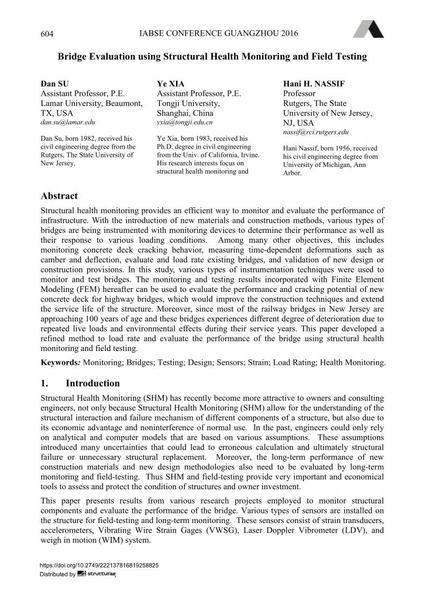Bridge Evaluation using Structural Health Monitoring and Field Testing

|
|
|||||||||||
Détails bibliographiques
| Auteur(s): |
Dan Su
Ye Xia Hani H. Nassif |
||||
|---|---|---|---|---|---|
| Médium: | papier de conférence | ||||
| Langue(s): | anglais | ||||
| Conférence: | IABSE Conference: Bridges and Structures Sustainability - Seeking Intelligent Solutions, Guangzhou, China, 8-11 May 2016 | ||||
| Publié dans: | IABSE Conference, Guangzhou, China, 8 – 11 May 2016 | ||||
|
|||||
| Page(s): | 604-612 | ||||
| Nombre total de pages (du PDF): | 9 | ||||
| Année: | 2016 | ||||
| DOI: | 10.2749/222137816819258825 | ||||
| Abstrait: |
Structural health monitoring provides an efficient way to monitor and evaluate the performance of infrastructure. With the introduction of new materials and construction methods, various types of bridges are being instrumented with monitoring devices to determine their performance as well as their response to various loading conditions. Among many other objectives, this includes monitoring concrete deck cracking behavior, measuring time-dependent deformations such as camber and deflection, evaluate and load rate existing bridges, and validation of new design or construction provisions. In this study, various types of instrumentation techniques were used to monitor and test bridges. The monitoring and testing results incorporated with Finite Element Modeling (FEM) hereafter can be used to evaluate the performance and cracking potential of new concrete deck for highway bridges, which would improve the construction techniques and extend the service life of the structure. Moreover, since most of the railway bridges in New Jersey are approaching 100 years of age and these bridges experiences different degree of deterioration due to repeated live loads and environmental effects during their service years. This paper developed a refined method to load rate and evaluate the performance of the bridge using structural health monitoring and field testing. |
||||
| Mots-clé: |
design ponts
|
||||
